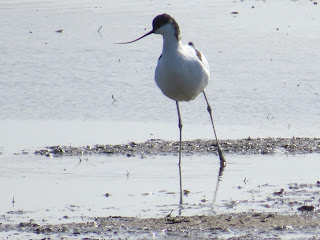 |
| Bumblebee on Coltsfoot |
It has been a lovely day at Titchwell today. The sun felt warm for the most part with just a slight chill from the sea breeze blowing inland. The sight of coltsfoot in bloom with a queen bumblebee pollenating them only cements the feeling that spring is here to stay.
 |
| Coltsfoot |
 |
| Avocets |
From the hides overlooking the pools, the avocets have returned in good numbers and I believe they are starting to pair up. They look absolutely splendid in the warm sunshine. The black-headed gulls are also starting to pair up. Their chocolate brown heads are fully developed once again (well most of them were anyway) and their constant screeching calls fill the air along with the piping sounds of avocets. Redshanks, teal, shovelers, shelducks, curlews, black-tailed godwits, dunlin and grey plovers were also here, but they were more into feeding and sleeping than pairing up like the gulls and avocets were. Brent geese were still about on the reserve with a large skein arriving as we were making our way back from the beach. It won't be long until they begin their migration back to their breeding grounds in Arctic Russia.
 |
| Black-headed Gull |
 |
| Black-tailed Godwits |
 |
| Shoveler |
 |
| Gadwall |
 |
| Male Teal |
 |
| Female Teal |
 |
| Moorhen |
 |
| Greylag |
 |
| Grey Plover |
 |
| Shelduck |
 |
| Curlew |
 |
| Knot |
 |
| Dunlin |
 |
| Redshank |
 |
| Black-tailed Godwit |
 |
| Brent Geese |
 |
| Red-crested Pochards |
Thanks to a volunteer with a scope, I was able to see some slightly distant red-crested pochards floating on a secluded pool surrounded by reed beds. The males were quite obvious with their striking red head and golden crowns. But these birds were not my true highlight of the day. That honour goes to the probable female hen harrier I saw today. Mum and I were watching a male marsh harrier swooping over the salt marshes, spooking everything up, when we suddenly saw a second harrier join it. They were pretty distant, but I'm pretty sure I could see a white rump on this second bird, which made me believe it was a hen harrier. Other bird watchers nearby overheard my discussion about the bird with Mum and they were soon watching the bird too. They also could see the white rump and came to the same conclusion as me. I mean, it isn't unusual to see a hen harrier here as they do overwinter in Norfolk, but it is still a special sighting all the same as they are incredibly rare in this country these days.

 |
| Marsh Harrier |
 |
| Oystercatcher |
At the beach, the tide was quite a long way out and felt like a slightly longer walk to the sea than normal compared to my other visits here. Many species of wading birds, such as turnstones and oystercatchers, were making the most of the exposed seaweed and mud close to the shore to feed. Meanwhile, out at sea, I could just make out the distant dots and shapes that were scoters and red-breasted mergansers, with the latter being even further out from view to photograph. At least I could see them much clearly through my binoculars. Also today, I saw reed buntings and some displaying meadow pipits.
 |
| Grey Plover |
 |
| Turnstone with a Knot in front of it |
 |
| Black-headed Gull that was by my feet! |
 |
| Common Scoter |
 |
| Meadow Pipit |
 |
| Reed Bunting |


















































Another excellent report Sean.
ReplyDelete